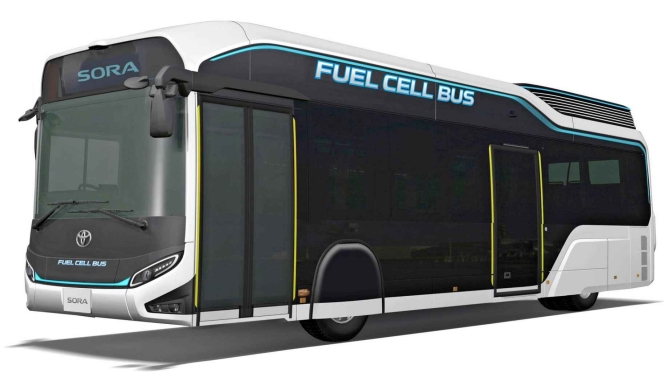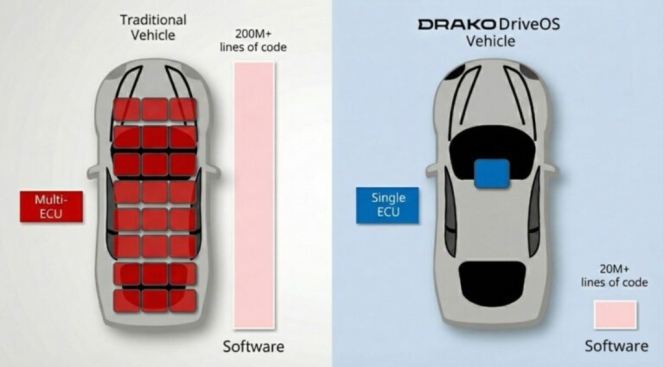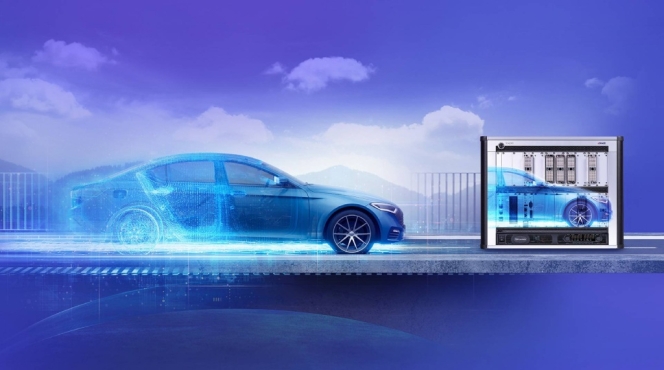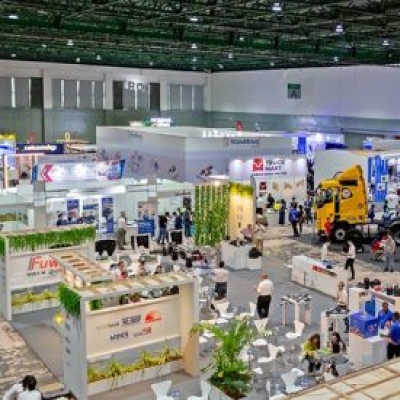Hydrogen Fuel Cell Technology Takes Over The Industry
- By MT Bureau
- October 10, 2020

 You must be wondering, what exactly is hydrogen fuel cell (HFC) technology, and what is so good about it? Hydrogen fuel is a clean fuel that is burned along with oxygen in an electrochemical power generator to generate electricity, and in the process, produces water and heat as by-products. What sets hydrogen fuel apart, however, is the fact that it serves as an alternative to diesel fuel in more ways than one: its fuel-cycle emits no pollutive exhaust, and through renewable energy, there contains no trace of greenhouse gas emissions. Vehicles that are powered by the hydrogen fuel cell, thus, significantly reduce our use and dependence on diesel oil and lower the chances of harmful emissions contributing to climate change. What started out as an experiment among startup companies and early projects is now dominating the commercial vehicle industry with many of the industry’s biggest players putting in large investments in the technology.
You must be wondering, what exactly is hydrogen fuel cell (HFC) technology, and what is so good about it? Hydrogen fuel is a clean fuel that is burned along with oxygen in an electrochemical power generator to generate electricity, and in the process, produces water and heat as by-products. What sets hydrogen fuel apart, however, is the fact that it serves as an alternative to diesel fuel in more ways than one: its fuel-cycle emits no pollutive exhaust, and through renewable energy, there contains no trace of greenhouse gas emissions. Vehicles that are powered by the hydrogen fuel cell, thus, significantly reduce our use and dependence on diesel oil and lower the chances of harmful emissions contributing to climate change. What started out as an experiment among startup companies and early projects is now dominating the commercial vehicle industry with many of the industry’s biggest players putting in large investments in the technology.
How Does it Work?
Hydrogen fuel can be produced through several methods, and in the commercial vehicle industry, fuel is processed in a fuel cell that is composed of three main components: an anode, a cathode, and an electrolyte membrane. This type of fuel cell is called a Proton-Exchange Membrane Fuel Cell, or also known as a polymer electrolyte membrane (PEM) fuel cell, which is mainly reserved for transport applications and stationary and portable fuel cell applications. The PEM fuel cell does its job by passing hydrogen through the anode, at which hydrogen molecules are split into electrons and protons. The former ones take the path of a circuit in the fuel cell to generate electric current and excess heat, while the protons go through the electrolyte membrane. At the same time, the PEM fuel cell passes oxygen from the surrounding air through the cathode on the other side, where the oxygen meets with the protons and electrons to produce water molecules. This does not get any simpler than your run-of-the-mill science experiment in school!
 What Are Fuel Stacks Then?
What Are Fuel Stacks Then?
What lies in the heart of a fuel cell vehicle (FCV) is the fuel cell stack. Because fuel cells generate less than 1.16 volts of electricity each, they must be assembled atop one another to create a fuel cell stack in order to generate enough power to run a vehicle. The potential power that can be generated by a fuel cell stack largely varies and is dependent on the number and the size of the individual fuel cells of the fuel cell stack, as well as the surface area of the PEM.
The Preferred Alternative
Hydrogen fuel cell has been proven to yield positive results for both the environment and the wallet in the long term.
Reduction in Greenhouse Gas Emissions
Contrary to diesel fuel, which emits greenhouse gases (GHGs) and carbon dioxide (CO2) that are large contributors to climate change, the only by-products of vehicles–when fueled by pure hydrogen–are heat and water with the release of zero tailpipe GHGs. While it is possible for FCVs to still generate GHGs, depending on the production method, the GHGs emitted is still far less great than those emitted by gasoline and diesel fuel. FCVs also eliminate the maintenance costs that come with storing diesel fuel that may prove harmful later on. Many of the industry’s big players make use of environmentally benign hydrogen in their hydrogen fuel cell products to eliminate and prevent the harmful impact of fuel spillage or leaks and air pollution.

 Cutback on Vehicle Oil Dependence
Cutback on Vehicle Oil Dependence
Many companies have incorporated hydrogen fuel cells in their corporate sustainability programmes, and the industry is seeing a shift of focus from diesel fuel to environmentally friendly alternatives. With the industry soon to be saturated with FCVs, our dependence on foreign oil will be significantly reduced and eventually eradicated. Hydrogen can be extracted sustainably from domestic sources, such as natural gas and coal, as well as from renewable sources, such as water, biogas, and agricultural waste. From an economic perspective, this would allow us to be less affected by oil price hikes and drops in the volatile oil market.
Lowering of Operational Costs
Hydrogen fuel cells require little to no maintenance as they eliminate the need to change, charge, and manage batteries, a maintenance check that is necessary for batteries, internal combustion generators, and the like. Hydrogen fuel cell units have a longer running time than do lead-acid batteries and, when power is running low, would not take more than five minutes to refuel. Companies that employ FCVs in their fleet benefit substantially from this as it reduces vehicle and personnel time, giving birth to a higher efficiency rate. This loss of regular maintenance saves not only money but labour, time, and the space for battery rooms as maintenance checks require optimal conditions.
 Increase in Energy Efficiency
Increase in Energy Efficiency
Hydrogen fuel cells are well known to be more energy-efficient than other forms of power. When a fuel cell vehicle is fueled by pure hydrogen, the hydrogen fuel cell has the potential to be up to 80-percent efficient. This means that the fuel cell converts up to 80 percent of the energy content of the hydrogen into electrical energy. The electric motor and inverter of the vehicle thus have the responsibility to convert that electrical energy into mechanical energy, with an average of 80 percent efficiency. Combined, this gives an overall 64-percent of increased efficiency when a vehicle is powered by a hydrogen fuel cell!
Increase in Durability and Reliability
Hydrogen fuel cells are notably more robust than other forms of fuel and can weather all types of conditions, from cold environments to harsh storms. This makes fuel cells a reliable asset to companies that engage commercial vehicles in tough environments. Additionally, because they do not have any moving parts, hydrogen fuel cells operate quietly even in the midst of a snowstorm!
With environmentally friendly applications and time-consuming maintenance, we are beginning to see the boom of hydrogen fuel cell technology in the commercial vehicle industry, and with good reason! (MT)
(Credits / Sources: U.S Energy Information Administration, Hydrogenics, Toyota, Verdict Media, Stanford University, University of Nebraska, Fuel Economy, Plug Power)
Drako Tech Unveils DriveOS With Single-ECUArchitecture
- By MT Bureau
- December 17, 2025

California-based Drako Tech has announced DriveOS with HyperSafety, an automotive operating system designed for single-Electronic Control Unit (ECU) operation. The platform consolidates vehicle subsystems, including control systems, ADAS and digital cockpit, into one unit to reduce costs and enable over-the-air (OTA) updates.
Launched in 2015 and utilised in Drako GTE and Drako Dragon vehicles, DriveOS supports internal combustion, electric and hybrid propulsion systems.
The HyperSafety system provides real-time performance via a single-ECU architecture. According to Drako Tech, the networking backbone facilitates communication four times faster than multi-ECU Time-Sensitive Networking (TSN) automotive Ethernet.
The architecture employs hardware isolation and redundancy to maintain operation during component failures. By using a reduced code footprint and hardware partitioning, the platform aims to limit attack surfaces for cyber security and streamline validation processes.
Industry Integration
Drako Tech provides development environments that run natively on DriveOS:
- Control Systems: Allows engineers to build vehicle controls from Simulink models.
- Digital Cockpit: A system for instrument clusters, navigation and multimedia.
- ADAS: A software foundation for driver assistance with low-latency control.
The platform addresses the complexity of multi-ECU architectures, which typically require separate units for functions such as seats, doors and thermal management. Drako Tech uses a separation kernel to run safety-critical systems alongside non-critical systems, such as infotainment, on the same ECU.
DriveOS introduces hard real-time capabilities to Linux without requiring kernel changes. This allows developers to use Linux libraries and tools for safety-critical systems.
Key features include:
- Performance: 108-microsecond end-to-end performance compared to 514 microseconds for TSN Ethernet.
- Consolidation: The ability to move functions onto a single PC architecture to reduce hardware mass and complexity.
- Redundancy: Hardware-backed isolation ensures faults in one subsystem do not affect driving functions.
- Cloud Integration: Real-time fleet management and diagnostics without creating access paths to control systems.
Dean Drako, CEO, Drako Tech, said, “Nearly half of the cost of new vehicles is tied up in software and electronics. Drako Tech now offers all OEMs worldwide – regardless of size or influence – a definitive leap in their ability to deliver exceptionally safe, connected, AI-enhanced vehicles, with massive cost advantages. We are the first to achieve the ultimate goal – a single-ECU, hard real-time operating system and unified electronics architecture with mixed criticality – while providing OEMs a flexible deployment path.”
dSPACE To Present AI-Driven Test Solutions For SDV At CES 2026
- By MT Bureau
- December 17, 2025

German technology company dSPACE is set to showcase end-to-end test solutions at CES 2026 to assist vehicle manufacturers with the development of software-defined vehicles (SDV).
The company will present a validation portfolio featuring AI-supported software-in-the-loop (SIL) and hardware-in-the-loop (HIL) solutions.
It is exploring how generative and agentic AI technologies can support SIL testing and enable CI/CD pipelines for validation. An exhibit will demonstrate a Visual Studio Code and GitHub Copilot solution for the generation of virtual ECUs for SIL tests.
To meet the requirements of short-cycle development, dSPACE is demonstrating a CI/CT concept presenting a cloud-native validation approach. This includes a GitLab pipeline integrated with VEOS, the dSPACE SIL test software, and SCALEXIO, the HIL test platform.
dSPACE is also presenting a HIL Farm Management Demo designed to increase test efficiency. This displays the availability and utilisation of HIL systems and potential errors to reduce system downtimes and improve the use of test resources.
The technology company will use its test solutions for battery charging and battery management systems to demonstrate end-to-end SIL/HIL validation. Efficiency is increased by reusing test cases, simulation models, bus configurations and user interfaces across both methods. This allows for the demonstration of functions, including conformance tests, with the same layouts and cases.
The company is introducing DARTS ARROW, a radar solution for functional testing of sensors. Developed for end-of-line tests and periodic technical inspections, it validates safety systems such as emergency braking and lane departure warnings by simulating traffic scenarios to detect sensor errors.
For security, dSPACE will present HydraVision, a cybersecurity test framework. Using test case templates, it allows for the integration of cybersecurity tests into the development process to identify and mitigate weak points.
Additionally, the new SCALEXIO Essential system expands the SCALEXIO real-time platform. It is designed for the validation of edge ECUs for mechatronic applications in the automotive, agricultural, and construction machinery sectors. The system includes a software package and is intended as a cost-efficient entry point for HIL testing.
Greaves Cotton Appoints Santosh Singh As Chief Strategy And AI Officer
- By MT Bureau
- December 16, 2025

Greaves Cotton has appointed Santosh Singh as Chief Strategy and AI Officer. He will be based in Mumbai and will lead strategy, transformation, AI-led enterprise capability building and business excellence for the Greaves Cotton Group.
Singh comes with over two decades of experience in strategy, business excellence, innovation, and AI-led enterprise transformation. He joins Greaves Cotton from Tata Technologies (TTL), where he served as Global Head – Marketing and Business Excellence. During his tenure there, he co-led the enterprise GenAI roadmap and developed use cases focused on customer engagement and productivity.
His primary mandate is to drive the Greaves.NEXT strategy, the company’s roadmap for growth across the energy, mobility and industrial solutions sectors.
In his new role, Singh will focus on accelerating growth for Greaves Technologies (GTL), developing an enterprise-wide AI roadmap, and establishing partnerships with hyperscalers and AI labs.
Parag Satpute, Managing Director & Group CEO, Greaves Cotton, said, “We are pleased to welcome Santosh to the leadership team. His extensive expertise in strategy, digital transformation, and AI will play a significant role in shaping Greaves’ next phase of growth. His global experience will further strengthen our innovation roadmap and support our long-term business priorities.”
Singh will also work across business units to incubate and scale growth vectors and lead business excellence initiatives.
Luminar Sells Photonics Division To Quantum Computing Inc For $110 Million
- By MT Bureau
- December 16, 2025

Luminar Technologies, Inc., a global technology company advancing safety, security and autonomy across various sectors, has announced it has agreed to sell its wholly owned subsidiary, Luminar Semiconductor, Inc. (LSI), to Quantum Computing Inc. (QCi) for USD 110 million in an all-cash transaction.
QCi is an integrated photonics and quantum optics technology company focused on photonics-driven technologies and sensing applications. LSI's innovation platform and engineering depth align with QCi’s strategic priorities in optical systems, chip-scale innovation and photonic architectures. The acquisition is expected to position LSI to grow and capitalise on the demand for photonics solutions.
Paul Ricci, CEO, Luminar, said, "We are pleased to partner with QCi as they continue to accelerate their photonics roadmap. QCi’s focus on photonics-driven technologies provides an aligned platform for LSI to expand its customer base, accelerate growth opportunities, and invest in markets where long-term demand for high-reliability optical systems is increasing. We are incredibly proud of the LSI team for the progress they have made to reach this milestone, and we are excited for the opportunities ahead for LSI under QCi’s ownership.”
Yuping Huang, CEO, Quantum Computing Inc, said, "I’m excited about the opportunity to partner with the exceptional team and valued customers of LSI. There is clear strategic alignment and shared vision between our organizations, creating strong momentum from day one. Following the closing, we will move quickly to invest in and scale LSI’s existing business, while bringing our teams together to accelerate our quantum photonics roadmap. This is a powerful combination, and I’m energized by what we will achieve together.”
In a separate announcement, Luminar announced that it has initiated voluntary chapter 11 cases in the U.S. Bankruptcy Court for the Southern District of Texas. LSI is not a debtor in the chapter 11 cases and is operating in the ordinary course. Because LSI is a subsidiary of Luminar, the transaction will require the approval of the bankruptcy court via a Section 363 sale process, which the parties expect to receive by the end of January 2026, subject to closing conditions.






Comments (0)
ADD COMMENT